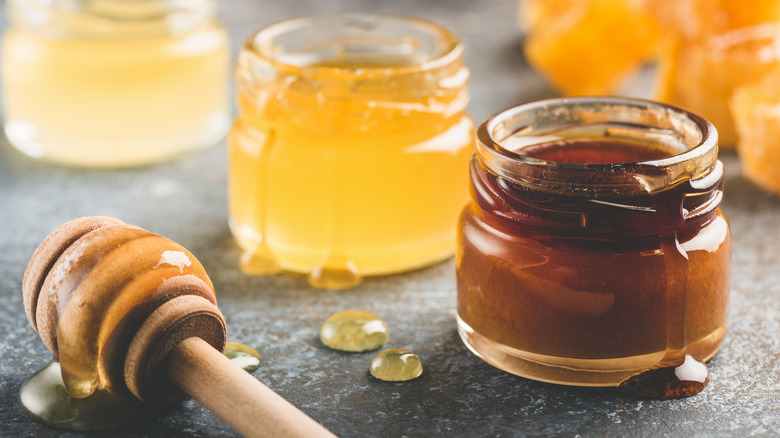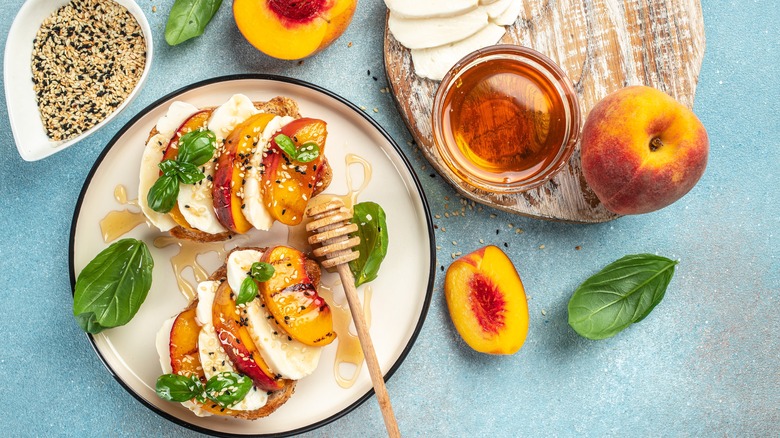What's The Difference Between Regular Honey And Raw?
If you decided to stir some honey into your tea this morning, you likely went into your cabinet and searched for the baby bear-shaped jar filled with sweet golden purified liquid. But if you want something that is a little closer to the honey first introduced into our diets 8,000 years ago, you may want to reach for raw honey. Raw honey, which is sometimes cloudy, often crystalized, and perhaps jarred with a piece or two of honeycomb, may be a little less golden — but it's certainly just as sweet.
The honey you're most likely to find on store shelves is conventional honey, which is pasteurized, heated, and filtered before it's packaged. Raw honey, which is more commonly found at farmers' markets and natural food stores, is the same honey you see dripping from honeycombs when they're pulled from the hives. Unlike conventional honey, most of it goes straight from the hive to the jar without pasteurization, heat, or filtration.
Before conventional honey is packaged, it goes through an intense heating process that ensures a consistent color and texture and enhances shelf life. It also creates a smoother honey by removing any crystallization. Although you may find some crystallization in raw honey, it doesn't affect its flavor or quality.
The benefits of raw honey versus regular honey
Honey is considered to be nutritious and to have several health benefits. It is unknown, however, whether or not the nutrients found in regular honey are destroyed under the intense heat used in pasteurization. Since raw honey does not go through that process, it is thought to retain important antioxidants, vitamins, minerals and enzymes. (That being said, it's not concretely been proven one way or the other.)
In addition, raw honey often contains pollen, beeswax and other material that might be considered undesirable and are filtered out in conventional honey. These are also thought to have health benefits. Many of honey's benefits — including wound healing, cough suppression, heart health and gut health — are attributed to bee pollen. It's made up of grains of pollen picked up by the bees while pollinating flowers. In the hive, it is mixed with nectar and honey and gland secretions from the bees. Although its specific make-up and benefits are dependent on the type of flowers they pollinate, studies show bee pollen has high levels of proteins, dietary fiber, fats, carbohydrates and minerals.
Another substance found in raw honey is called propolis. Also known as bee glue, propolis is made from a combination of beeswax and saliva and is used in the construction and protection of the hives. Studies have shown that propolis also has antioxidant and anti-inflammatory properties and may be beneficial for heart health.
Can I use raw honey and conventional honey interchangeably?
You can use raw honey the same way that you would use regular honey — it is just as delicious eaten straight from the jar, spread over toast or mixed into yogurt. However, if you are considering purchasing raw honey for its health benefits alone, you should avoid using it in cooking and baking, since the heat may destroy some of the beneficial nutrients.
When choosing between raw and regular honey, you should also consider differences in color and texture. If you're not worried about the loss of nutrients, go ahead and use it in baking. You'll want to first make sure it hasn't crystallized or you may get lumps or clusters of sweetness in your finished product. You can also decrystallize honey yourself. If you're having guests and want to serve honey as a condiment or drizzle it over a dish or some cheese, you may want the silky smooth, golden consistency of regular honey. Either way, you can't go wrong with nature's taste of sweetness.


